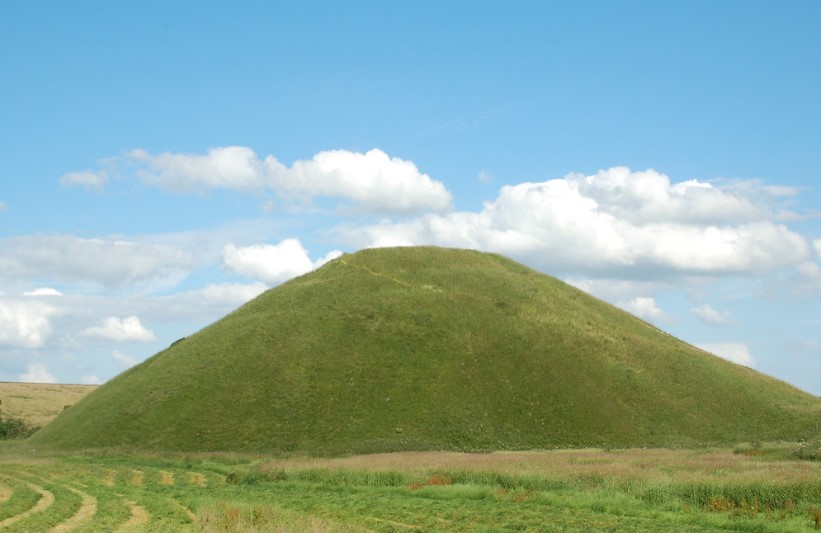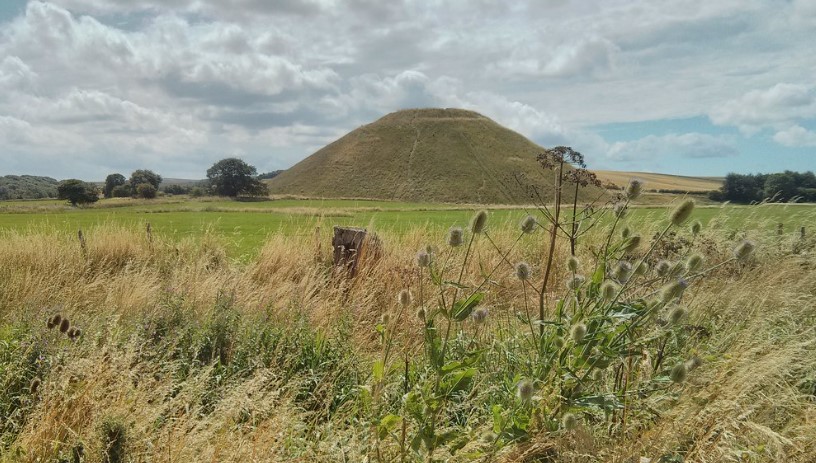Silbury Hill is an ancient monument located in Wiltshire, England, and is considered one of the largest man-made mounds in Europe. It was constructed during the late Neolithic period, around 4,500 years ago, and is part of the complex network of prehistoric monuments in the area, including Stonehenge and Avebury.
The exact purpose of Silbury Hill is still a mystery, but it is believed to have served as a monument of spiritual or religious significance, as well as a symbol of power and prestige for the ruling elites of the time. The hill was built by layering soil and earth, with the highest point standing at a height of 40 meters (130 feet) and a base circumference of about 400 meters (1,312 feet). Silbury Hill consists of chalk and clay from the surrounding area and covers 2 hectares, with a circular base 167 meters in diameter and a flat-topped summit 30 meters wide.
The hill was built in stages between 2400 and 2300 BC and required 500 men to work for 15 years to deposit and shape 248,000 cubic meters of earth. It is believed to have been constructed by an authoritarian, theocratic power elite with control over southern Britain. The first evidence of construction was a gravel core with a revetting curb, followed by alternating layers of chalk rubble and earth, and the summit has a step surrounding it. The top was originally rounded but flattened in the medieval period for a building.
The inside of the hill is filled with layers of material, including clay, flints, turf, moss, topsoil, gravel, freshwater shells, mistletoe, oak, hazel, sarsen stones, ox bones, and antler tines. Despite numerous excavations, few prehistoric artifacts have been found within the hill, and the exact purpose of the structure remains a mystery. In contrast, Roman and medieval items have been discovered on and around the site since the 19th century.
Over the years, various theories have been proposed to explain the purpose of Silbury Hill, including suggestions that it served as a burial mound, an astronomical observatory, or even a temple. However, despite numerous excavations and surveys, no concrete evidence of a specific function has been found.
In addition to its mysterious purpose, Silbury Hill is also significant for its impressive construction and engineering. The mound was built without the use of mortar or any other binding agent, and it has withstood the test of time for thousands of years. The fact that such a large structure was constructed without the use of modern technology is a testament to the skill and ingenuity of the prehistoric people who built it.
It is possible that Avebury and Silbury are culturally or functionally related to a number of Neolithic monuments in Wiltshire, such as Marden and Stonehenge. Silbury Hill is now a protected monument and is managed by English Heritage. Visitors to the site can hike to the top of the hill and enjoy views of the surrounding countryside. It is also possible to arrange guided tours of the site and learn more about the history and significance of Silbury Hill.
Silbury Hill is not the only prehistoric mound built in the area, with Marlborough Mound and Marden Henge also showing construction dates around 2500 BC. A project to investigate other potential mounds was conducted, with 20 sites selected for core sampling and surveying. Out of these, only the Skipsea Castle mound was found to be prehistoric and dated to 800-400 BC during the British Iron Age. The investigation confirmed that Neolithic mound-building was limited to the Kennet and Avon valleys, and no other mounds in Britain compare to Silbury Hill.
Keep in mind that that hill is not a pyramid; it is home to diverse species of vegetation, including the rare knapweed broomrape, that thrives in its chalk grassland habitat. The area, which covers 2.3 hectares (5.7 acres), was designated as a Site of Special Scientific Interest in 1965 and 1986. Therefore, Silbury Hill is a remarkable monument that is not only significant for its impressive size and construction, but also for its mystery and historical significance. It is a must-visit destination for anyone interested in prehistoric history and the ancient cultures of England. Read More – Gilbert Hill – A Monolith Column of Black Basalt






